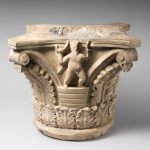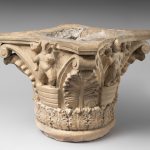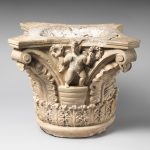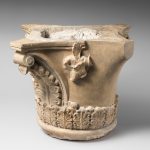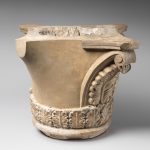| Artefact ID | 1768 |
| TM ID | - |
| Findspot (DEChriM ID) | 3 (Maʿbad Hībis) | Class | Architectural element |
| Material | Stone |
| Description | Limestone capital with putti holding wreaths and with acanthus leaves. Dimensions: H. 49 cm; W. 58 cm; D. 58 cm; Wt. 98.4 kg. The capital sat atop the south-east column of the church (Winlock 1941: VI; see also plan of Maʿbad Hībis). It has "a tenon hole in the bottom, 4.5 to 5 cm. square and 4 cm. deep, for its attachment to the shaft" of the column (Winlock 1941: 46). On the top of the capital, Winlock read the graffito iwxannhs gerapan (= ἔγραψαν), "John engraved (it)". Winlock adds the following details: "After the destruction of the church, the capital was hollowed out for a mortar and broken in two, probably during its use as such." "Like the fragments of columns, those of the capital had been thickly covered with whitewash." (1941: 46). Winclock gives the following description of the whereabouts of this capital: "The architraves of the portico, for example, had been so shattered that it seemed impossible to replace them, and by the end of the first season practically nothing of its east façade had come to light except the base and the capital of the southeast column with its well-preserved color. Thus it was that when, acting under Lythgoe's instructions, I asked Maspero for the capital in 1910, he decided to give it to the Metropolitan Museum as practically its sole return for an outlay which had made the restoration of the temple possible. Three years later, when Baraize was finishing the portico, he made a roughhewn block to take the place of the capital on the top of the restored column." (Winlock 1941: VI). |
| Selection criteria | Archaeological context associated with Christian markers |
| Date from | 350 |
| Date to | 399 |
| Dating criteria | See Maʿbad Hībis. |
| Absolute/relative date | Relative date |
| Archaeological context | Hibis temple. The Department of Medieval Art of the Metropolitan Museum has no further documentation associated with the precise context in which the capital was found. However, Winlock (1941, pl. XXVIII) states clearly that it belonged to the church installed inside the Hibis temple, the only part of the temple that underwent modifications at the time to which the capital dates, i.e. the 4th century. The capital was found during the 1909-1910 excavation season in Kharga of the Egyptian Expedition of the Metropolitan Museum of Art. It was acquired by the MMA in the division of finds and accessioned in 1910. |
| Accession number | New York, Metropolitan Museum of Art, no. 10.177.1. |


 Json data
Json data